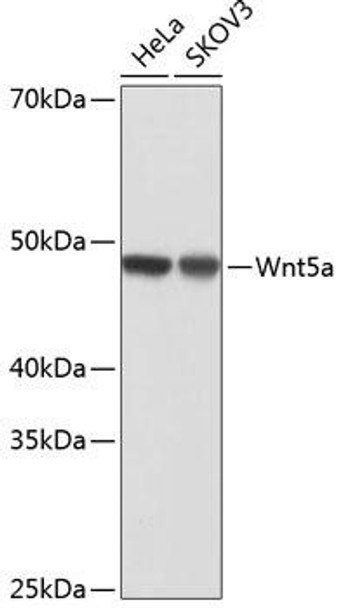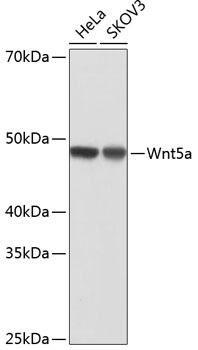Anti-Wnt5a Antibody (CAB19133)
- SKU:
- CAB19133
- Product type:
- Antibody
- Reactivity:
- Human
- Host Species:
- Rabbit
- Isotype:
- IgG
- Research Area:
- Cell Biology
Description
| 抗体名: | Anti-Wnt5a Antibody |
| 抗体コード: | CAB19133 |
| 抗体サイズ: | 20uL, 50uL, 100uL |
| 申し込み: | WB IHC |
| 反応性: | Human |
| 宿主種: | Rabbit |
| 免疫原: | A synthesized peptide derived from human Wnt5a |
| 申し込み: | WB IHC |
| 推奨希釈: | WB 1:500 - 1:2000 IHC 1:50 - 1:200 |
| 反応性: | Human |
| ポジティブサンプル: | HeLa, SKOV3 |
| 免疫原: | A synthesized peptide derived from human Wnt5a |
| 精製方法: | Affinity purification |
| ストレージバッファ: | Store at -20°C. Avoid freeze / thaw cycles. Buffer: PBS with 0.02% sodium azide, 0.05% BSA, 50% glycerol, pH7.3. |
| アイソタイプ: | IgG |
| 順序: | Email for sequence |
| 遺伝子ID: | 7474 |
| Uniprot: | P41221 |
| セルラーロケーション: | |
| 計算された分子量: | 42kDa |
| 観察された分子量: | 42kDa |
| 同義語: | hWNT5A, Wnt5a, WNT5A |
| バックグラウンド: | The WNT gene family consists of structurally related genes which encode secreted signaling proteins. These proteins have been implicated in oncogenesis and in several developmental processes, including regulation of cell fate and patterning during embryogenesis. This gene encodes a member of the WNT family that signals through both the canonical and non-canonical WNT pathways. This protein is a ligand for the seven transmembrane receptor frizzled-5 and the tyrosine kinase orphan receptor 2. This protein plays an essential role in regulating developmental pathways during embryogenesis. This protein may also play a role in oncogenesis. Mutations in this gene are the cause of autosomal dominant Robinow syndrome. Alternate splicing results in multiple transcript variants. [provided by RefSeq, Jan 2012] |
| UniProt Protein Function: | WNT5A: Ligand for members of the frizzled family of seven transmembrane receptors. Can activate or inhibit canonical Wnt signaling, depending on receptor context. In the presence of FZD4, activates beta-catenin signaling. In the presence of ROR2, inhibits the canonical Wnt pathway by promoting beta-catenin degradation through a GSK3-independent pathway which involves down-regulation of beta-catenin-induced reporter gene expression. Suppression of the canonical pathway allows chondrogenesis to occur and inhibits tumor formation. Stimulates cell migration. Decreases proliferation, migration, invasiveness and clonogenicity of carcinoma cells and may act as a tumor suppressor. Mediates motility of melanoma cells. Required during embryogenesis for extension of the primary anterior-posterior axis and for outgrowth of limbs and the genital tubercle. Inhibits type II collagen expression in chondrocytes. Interacts with PORCN. Interacts with WLS. Expression is increased in differentiated thyroid carcinomas compared to normal thyroid tissue and anaplastic thyroid tumors where expression is low or undetectable. Expression is found in thyrocytes but not in stromal cells. Belongs to the Wnt family. 2 isoforms of the human protein are produced by alternative splicing. |
| UniProt Protein Details: | Protein type:Secreted; Secreted, signal peptide Chromosomal Location of Human Ortholog: 3p14.3 Cellular Component: clathrin coated vesicle membrane; endoplasmic reticulum lumen; extracellular region; extracellular space; Golgi lumen; plasma membrane Molecular Function:frizzled binding; protein binding; receptor agonist activity; receptor tyrosine kinase-like orphan receptor binding; transcription factor activity Biological Process: activation of JNK activity; activation of MAPK activity; activation of NF-kappaB transcription factor; activation of protein kinase B; axon guidance; cell fate commitment; embryonic skeletal development; epithelial to mesenchymal transition; genitalia development; keratinocyte differentiation; lens development in camera-type eye; male gonad development; negative regulation of apoptosis; negative regulation of fat cell differentiation; negative regulation of transcription, DNA-dependent; neuron differentiation; olfactory bulb interneuron development; palate development; positive regulation of angiogenesis; positive regulation of cGMP metabolic process; positive regulation of chemokine biosynthetic process; positive regulation of cytokine secretion during immune response; positive regulation of endothelial cell proliferation; positive regulation of fibroblast proliferation; positive regulation of inflammatory response; positive regulation of interleukin-1 beta secretion; positive regulation of interleukin-6 production; positive regulation of macrophage activation; positive regulation of ossification; positive regulation of protein catabolic process; positive regulation of transcription from RNA polymerase II promoter; positive regulation of transcription, DNA-dependent; response to organic substance; Wnt receptor signaling pathway; Wnt receptor signaling pathway, calcium modulating pathway; Wnt receptor signaling pathway, planar cell polarity pathway; wound healing Disease: Robinow Syndrome, Autosomal Dominant |
| NCBI Summary: | The WNT gene family consists of structurally related genes which encode secreted signaling proteins. These proteins have been implicated in oncogenesis and in several developmental processes, including regulation of cell fate and patterning during embryogenesis. This gene encodes a member of the WNT family that signals through both the canonical and non-canonical WNT pathways. This protein is a ligand for the seven transmembrane receptor frizzled-5 and the tyrosine kinase orphan receptor 2. This protein plays an essential role in regulating developmental pathways during embryogenesis. This protein may also play a role in oncogenesis. Mutations in this gene are the cause of autosomal dominant Robinow syndrome. Alternate splicing results in multiple transcript variants. [provided by RefSeq, Jan 2012] |
| UniProt Code: | P41221 |
| NCBI GenInfo Identifier: | 212276478 |
| NCBI Gene ID: | 7474 |
| NCBI Accession: | P41221.2 |
| UniProt Secondary Accession: | P41221,Q6P278, A8K4A4, |
| UniProt Related Accession: | P41221 |
| Molecular Weight: | 42kDa |
| NCBI Full Name: | Protein Wnt-5a |
| NCBI Synonym Full Names: | Wnt family member 5A |
| NCBI Official Symbol: | WNT5A |
| NCBI Official Synonym Symbols: | hWNT5A |
| NCBI Protein Information: | protein Wnt-5a |
| UniProt Protein Name: | Protein Wnt-5a |
| Protein Family: | Protein |
| UniProt Gene Name: | WNT5A |


